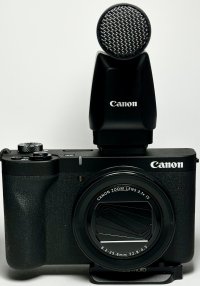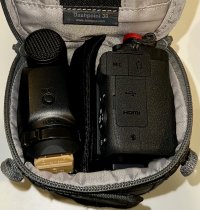First impression when I took it out of the box, it's a chunky little thing but the size is manageable. Very solid feel. The grip is small but the textured surface is fairly 'sticky' so it doesn't feel like it will slip out of my hand.
I wasn't surprised that the LC-E17 wall-wart charger was not included, but only because I had already perused the manual.
For those needing an Arca-Swiss compatible plate, the Hejnar Photo D052 (for the G5X/G7X) fits perfectly – the battery/card door opens fully, anti-twist nubs engage properly and the alignment mark is on the optical axis.
The hole for the wrist strap on the right side of the camera is very small (there's a much larger lug on the left side for a neck strap, though one is not included). The supplied wrist strap stayed in the box, a Peak Design anchor loop fit through the hole on the right side, but getting it in was a very tight fit. Now I can use the PD wrist strap when needed, I share it across the R8, M6II and M6, all of which have a PD anchor on them.
In terms of cases, the V1 is a perfect fit in my little Lowepro Dashpoint 20.
Control layout is not great, but that's the norm for a P&S camera. The control ring at the base of the lens is not very deep and is very close to the body (not that Canon had other options). I find it a bit difficult to turn because I end up with half of my finger(s) on the thin, fixed portion of the lens barrel distal to the control ring. Small adjustments are actually easier with the middle finger of my right hand that's wrapped around the front of the body. The ring is clickless, which makes sense given the video-focused intent of the camera, but is not ideal for stills. The control dial on the back is not conveniently located, but it's in the typical place for a P&S.
The menus will be familiar to anyone using a Canon ILC. There are a few control customizations, which is nice. It's possible to set up back button focus with the * button, though like the rear dial that's not a comfortable reach for the my thumb. I wish Canon had allowed the movie record button (next to the shutter button) to start AF in stills mode, but in their infinite wisdom only the * button can do that (in addition to the shutter half press, of course). It was a little funny to me that Canon lets you set the shutter button to only metering start without assigning AF to the * button. I guess they figure if you aren't in A+ mode and you manage to leave your camera with no way to focus, that's on you. I suppose MF could be assigned to the control ring, too old-school for me. I do like that there are three C# modes available.
In terms of performance, it's quite capable from first impressions. Power up is pretty quick, focus is snappy like you'd expect from current DFAP sensors. I haven't tried tracking moving subjects, but on the pretty simple test of setting focus on an object or myself in a mirror then rapidly moving the camera around to change the framing, the subject lock-on is very good. I haven't really looked at image quality, but with modern sensors that's proportional to sensor size so I know what to expect. It will 'improve' once DxO supports it (which I assume they will, I'll shoot RAW + JPG in the meantime).
I bought the V1 for two reasons: a walkaround camera and for occasional video shooting. The advantage as a walkaround camera is obvious, the V1 in the Dashpoint 20 case is small enough for a large pocket or to stay in my work satchel with my laptop. To drive the point home, here are possible walkaround combos in my kit (V1, M6II + M22/2, R8 + RF 28/2.8).

The V1 is the most compact overall (though the body itself is bulkier than the M6II). In terms of video, I typically use the Canon Vixia HF G60 camcorder for that. But in some venues that's not permitted, and for low light use where I don't need to zoom in too much the larger sensor of the V1 (vs. the 1" sensor in the G60) will have a bit less noise.
Ok...enough talk, on to some sample images. I was in Boston today, so I took a quick walk around the Fan Pier area of the Seaport District. Actual focal lengths are indicated, keep in mind the FFeq range of 16-50mm is actually 8.2-25.6mm.
"Rowes Wharf Wide"

PowerShot V1, 8.2mm, 1/400 s, f/5.6, ISO 100
"Rowes Wharf Tele"

PowerShot V1, 25.6mm, 1/400 s, f/5.6, ISO 125
"Seaport Condos"
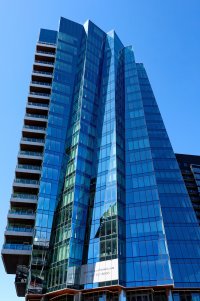
PowerShot V1, 15.3mm, 1/400 s, f/5.6, ISO 100
"Boston Cruise"
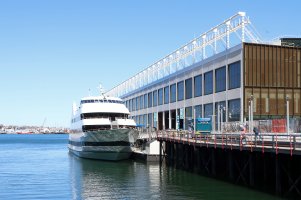
PowerShot V1, 25.6mm, 1/400 s, f/5.6, ISO 100
"Spring Forsythia"

PowerShot V1, 25.6mm, 1/400 s, f/4.5, ISO 100
One last one near home, I was curious about the sunstars from the 9-bladed aperture. I was surprised that the narrowest aperture available is f/11 (throughout the zoom range), though of course diffraction is going to be an issue at that point.
"Sunstar"
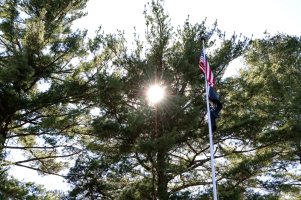
PowerShot V1, 25.6mm, 1/400 s, f/11, ISO 1600
Overall, I'm impressed with the camera and looking forward to using it more frequently.
I wasn't surprised that the LC-E17 wall-wart charger was not included, but only because I had already perused the manual.
For those needing an Arca-Swiss compatible plate, the Hejnar Photo D052 (for the G5X/G7X) fits perfectly – the battery/card door opens fully, anti-twist nubs engage properly and the alignment mark is on the optical axis.
The hole for the wrist strap on the right side of the camera is very small (there's a much larger lug on the left side for a neck strap, though one is not included). The supplied wrist strap stayed in the box, a Peak Design anchor loop fit through the hole on the right side, but getting it in was a very tight fit. Now I can use the PD wrist strap when needed, I share it across the R8, M6II and M6, all of which have a PD anchor on them.
In terms of cases, the V1 is a perfect fit in my little Lowepro Dashpoint 20.
Control layout is not great, but that's the norm for a P&S camera. The control ring at the base of the lens is not very deep and is very close to the body (not that Canon had other options). I find it a bit difficult to turn because I end up with half of my finger(s) on the thin, fixed portion of the lens barrel distal to the control ring. Small adjustments are actually easier with the middle finger of my right hand that's wrapped around the front of the body. The ring is clickless, which makes sense given the video-focused intent of the camera, but is not ideal for stills. The control dial on the back is not conveniently located, but it's in the typical place for a P&S.
The menus will be familiar to anyone using a Canon ILC. There are a few control customizations, which is nice. It's possible to set up back button focus with the * button, though like the rear dial that's not a comfortable reach for the my thumb. I wish Canon had allowed the movie record button (next to the shutter button) to start AF in stills mode, but in their infinite wisdom only the * button can do that (in addition to the shutter half press, of course). It was a little funny to me that Canon lets you set the shutter button to only metering start without assigning AF to the * button. I guess they figure if you aren't in A+ mode and you manage to leave your camera with no way to focus, that's on you. I suppose MF could be assigned to the control ring, too old-school for me. I do like that there are three C# modes available.
In terms of performance, it's quite capable from first impressions. Power up is pretty quick, focus is snappy like you'd expect from current DFAP sensors. I haven't tried tracking moving subjects, but on the pretty simple test of setting focus on an object or myself in a mirror then rapidly moving the camera around to change the framing, the subject lock-on is very good. I haven't really looked at image quality, but with modern sensors that's proportional to sensor size so I know what to expect. It will 'improve' once DxO supports it (which I assume they will, I'll shoot RAW + JPG in the meantime).
I bought the V1 for two reasons: a walkaround camera and for occasional video shooting. The advantage as a walkaround camera is obvious, the V1 in the Dashpoint 20 case is small enough for a large pocket or to stay in my work satchel with my laptop. To drive the point home, here are possible walkaround combos in my kit (V1, M6II + M22/2, R8 + RF 28/2.8).

The V1 is the most compact overall (though the body itself is bulkier than the M6II). In terms of video, I typically use the Canon Vixia HF G60 camcorder for that. But in some venues that's not permitted, and for low light use where I don't need to zoom in too much the larger sensor of the V1 (vs. the 1" sensor in the G60) will have a bit less noise.
Ok...enough talk, on to some sample images. I was in Boston today, so I took a quick walk around the Fan Pier area of the Seaport District. Actual focal lengths are indicated, keep in mind the FFeq range of 16-50mm is actually 8.2-25.6mm.
"Rowes Wharf Wide"

PowerShot V1, 8.2mm, 1/400 s, f/5.6, ISO 100
"Rowes Wharf Tele"

PowerShot V1, 25.6mm, 1/400 s, f/5.6, ISO 125
"Seaport Condos"

PowerShot V1, 15.3mm, 1/400 s, f/5.6, ISO 100
"Boston Cruise"

PowerShot V1, 25.6mm, 1/400 s, f/5.6, ISO 100
"Spring Forsythia"

PowerShot V1, 25.6mm, 1/400 s, f/4.5, ISO 100
One last one near home, I was curious about the sunstars from the 9-bladed aperture. I was surprised that the narrowest aperture available is f/11 (throughout the zoom range), though of course diffraction is going to be an issue at that point.
"Sunstar"

PowerShot V1, 25.6mm, 1/400 s, f/11, ISO 1600
Overall, I'm impressed with the camera and looking forward to using it more frequently.

